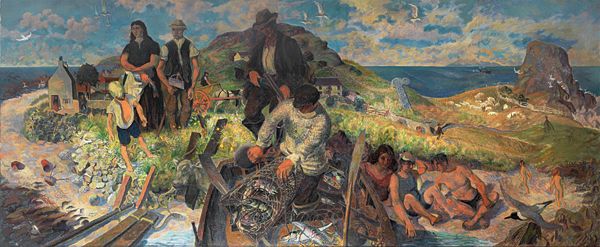
Hebridean Memory, 1951
Framed (ref: 5562)
Oil on canvas
127 x 297 cm (50 x 117 in.)
Tags: Gilbert Spencer oil big pictures murals

Oil on canvas
127 x 297 cm (50 x 117 in.)
Tags: Gilbert Spencer oil big pictures murals
Provenance: Private Collection
Exhibited: London, RBA Galleries, ‘Sixty Paintings for 51’, 1951, no 20; London, Royal Academy, 1955To celebrate the Festival of Britain in 1951 the Arts Council of Great Britain invited sixty artists to paint a large work, not less than 45 by 60 inches, on a subject of their choice. Francis Bacon, Edward Burra, Lucian Freud and Ben Nicholson were amongst those who contributed, and ‘Sixty Paintings for 51’ opened at the RBA galleries, one of a series of major visual arts exhibitions for the Festival.
Gilbert Spencer painted Hebridean Memory, a landscape set on the small Island of Canna in the Scottish Inner Hebrides. He had holidayed there in 1947, staying with John Lorne Campbell who had bought Canna outright in 1938, and was now living there as its Laird with his wife
Margaret in the prominent harbour property Canna House. Spencer and Campbell had been friends since the 1930s when they met in Oxford, where Spencer had been painting a series of murals depicting the Foundation of Bailliol College and Campbell was doing post-graduate work.
Hebridean Memory depicts several of Canna’s landmarks and the locals going about island activities – farming and lobster and mackerel
fishing – whilst visitors sunbathe. Rum features in the distance with MacBrayne’s steamer on its way over. A vision of contentment and plenty, the only incongruity is the man with the gun: Campbell, who wanted the island to be a sanctuary for wildlife, did not allow shooting. The composition also includes a whimsical depiction in the right foreground of the artist and his older brother Stanley as their younger selves.
Spencer has written about the trials of working on such a large-scale canvas, and that Hebridean Memory took him three years (with several incarnations) to achieve. After ‘Sixty Paintings for 51’ it was shown at the RA in 1955, but this is the first time it has been exhibited since then.